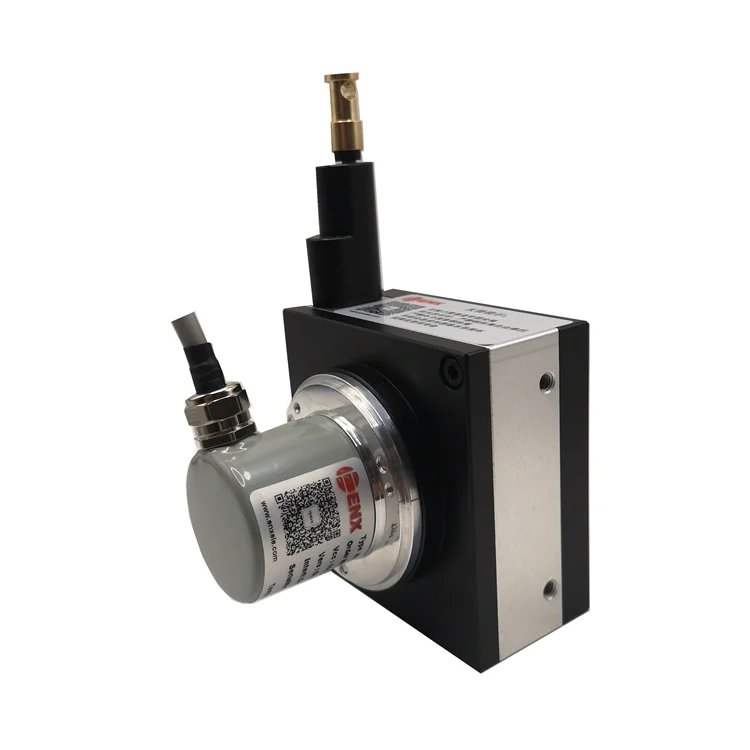High precision draw wire sensors - also known as string potentiometers, cable extension transducers, or wire actuated encoders - are sophisticated electromechanical devices used for measuring linear position and displacement with exceptional accuracy. In this blog post, Enxiao, a high performance industrial sensor manufacturing factory, will share the working principle of high precision draw wire sensor for sale.
1. Basic Operating Concept
At the core of a draw wire sensor lies a flexible, high-tensile-strength wire (usually stainless steel or a synthetic coated cable) wound around a precisely engineered drum or spool. One end of the wire is attached to the moving object whose position needs to be measured, while the other end is coiled on a spring-loaded spool inside the sensor housing. As the object moves, it pulls the wire out of the sensor, causing the spool to rotate. This rotational movement is then converted into an electrical signal that correlates directly with the displacement of the object.
The heart of the working principle is the direct translation of linear displacement into rotational motion, which is subsequently measured by a rotary sensor component such as a potentiometer, optical encoder, or Hall effect sensor. Each type of rotary sensor offers distinct advantages in terms of resolution, linearity, and signal output.
2. Key Components and Their Functions
A high precision draw wire sensor typically comprises the following main components:
- Measuring Cable (Draw Wire): A highly flexible and durable cable, often made of stainless steel or Kevlar-coated material, ensures longevity and minimal hysteresis. It must have low elongation and excellent fatigue resistance to maintain measurement accuracy.
- Spool and Spring Mechanism: The cable is wound onto a drum under tension, maintained by an internal constant-force or helical spring. This ensures that the wire is always taut, eliminating slack that could otherwise introduce measurement errors.
- Rotary Sensor Element:
- Potentiometer: A resistive element that changes resistance proportionally to rotation. Offers analog output.
- Incremental Encoder: Uses optical or magnetic techniques to provide pulses indicating motion increments, requiring external electronics for position calculation.
- Absolute Encoder: Provides a unique output for every position, maintaining position even after power loss.
- Coupling and Gear System: Ensures a consistent and calibrated relationship between the linear movement of the wire and the angular rotation of the sensor shaft. Precision gears are used to maintain high resolution and avoid backlash.
- Sensor Housing: An enclosure designed to protect internal components from dust, moisture, and mechanical damage. It often complies with industry-standard ingress protection (IP) ratings.

3. Measurement Principle and Signal Conversion
The fundamental measurement principle involves tracking the length of wire pulled from the sensor, which corresponds to the linear displacement of the attached object. As the wire is extended, the rotation of the drum is transmitted to the rotary sensor via a coupling mechanism.
- Mechanical-to-Rotational Conversion: As the linear distance increases, the cable unwinds from the spool.
- Rotational-to-Electrical Signal Conversion: The angular displacement is then converted into an electrical signal by the rotary sensor. Depending on the sensor type:
- A potentiometer varies its resistance across a voltage divider.
- An optical encoder emits digital pulses as a slotted disk interrupts a light source.
- A magnetic encoder detects angular change via magnetic field variations.
The output signal can be analog (0 - 10V, 4 - 20mA), digital (TTL, HTL, SSI, CANopen), or serial, depending on the application and sensor configuration.
4. Calibration and Linearity Considerations
Precision draw wire sensors are calibrated to ensure that the mechanical rotation of the spool matches the electrical output across the sensor's full range. High-end sensors incorporate compensation mechanisms for thermal expansion, cable stretch, and backlash.
- Linearity: The linearity of the sensor describes how accurately the electrical output corresponds to actual displacement. High precision sensors typically offer linearity error as low as ±0.01% of the full-scale range.
- Repeatability and Hysteresis: Repeatability refers to the sensor' s ability to reproduce the same output under identical conditions, while hysteresis measures the difference in output depending on the direction of movement. High-performance sensors minimize these effects using advanced materials and low-friction components.
- Temperature Compensation: Temperature changes can affect both the cable length and sensor electronics. Advanced models include compensation algorithms and thermally stable components to maintain consistent performance across a wide temperature range.
5. Advantages Over Other Displacement Sensors
Compared to LVDTs (Linear Variable Differential Transformers), laser displacement sensors, and magnetostrictive sensors, draw wire sensors offer a unique set of advantages:
- Compact Form Factor: The sensor housing is generally small relative to the measurement range, allowing for easy integration into tight spaces.
- Long Measurement Range: Capable of measuring distances from a few millimeters to tens of meters without compromising resolution.
- Ease of Installation: Minimal alignment requirements and flexible mounting options.
- Cost-Effectiveness: Especially favorable in applications requiring long-range measurement without high cost.
6. Applications in Industry
Due to their reliability and precision, draw wire sensors are deployed across a wide range of industries:
- Aerospace: Landing gear testing, flight control surface position monitoring.
- Automotive: Crash test systems, seat position detection, and durability testing rigs.
- Manufacturing Automation: Robotic arm positioning, press and injection molding monitoring.
- Civil Engineering: Structural monitoring of bridges and buildings under dynamic loads.
- Medical Devices: Patient positioning systems in diagnostics and therapy machines.
Each application may demand customized configurations, such as specialized mounting brackets, reinforced cables, or specific signal output standards.
Conclusion
The high precision draw wire sensor represents a fusion of mechanical engineering and sensor technology to provide accurate, reliable, and robust linear position measurement. By translating linear motion into rotational motion and then into an electrical signal, these sensors deliver exceptional performance across a vast array of demanding industrial and research applications. With ongoing developments in sensor electronics and materials science, draw wire sensors are poised to play a pivotal role in the future of precision motion control and industrial automation.
www.enxsensors.com
Enxiao